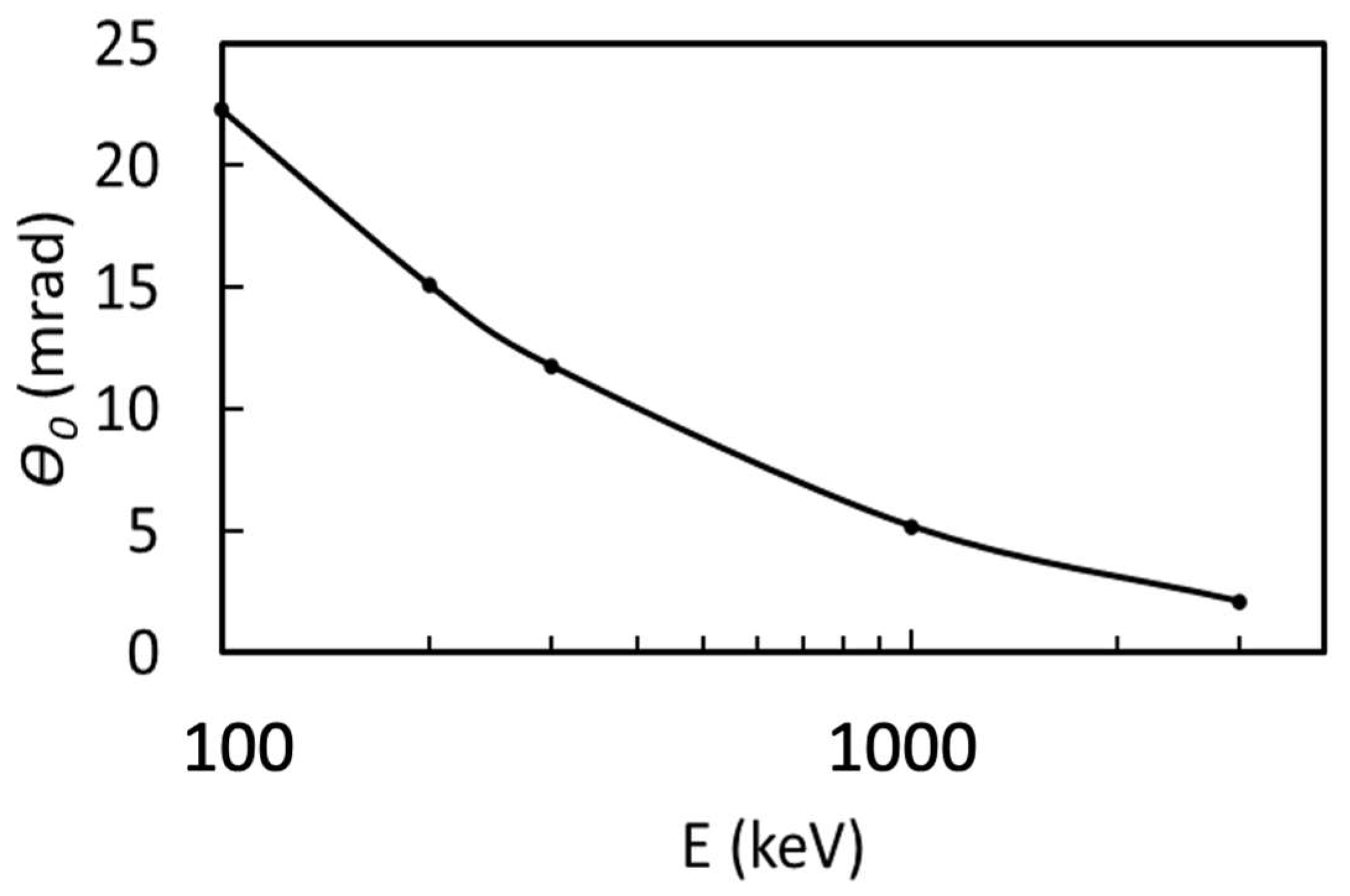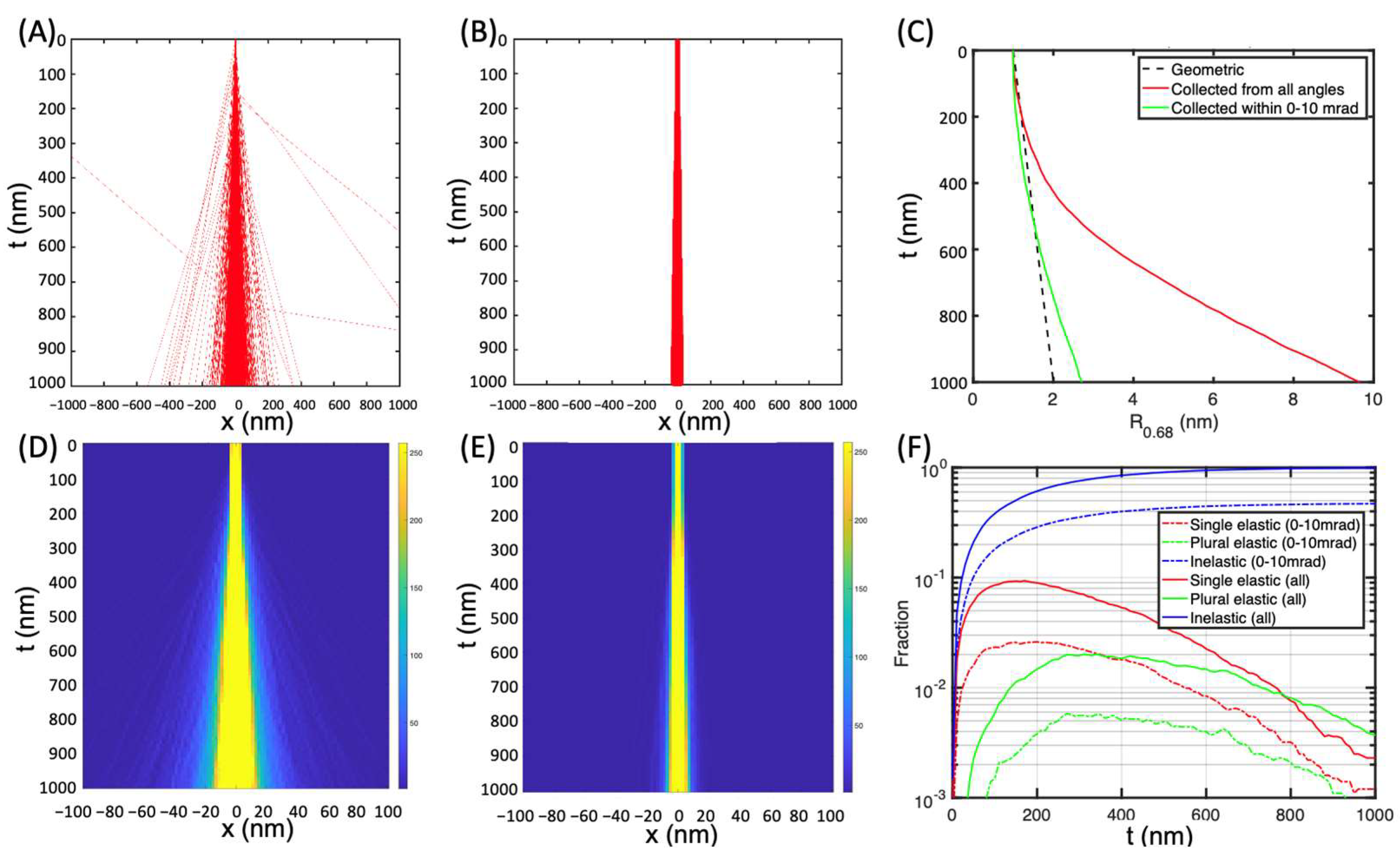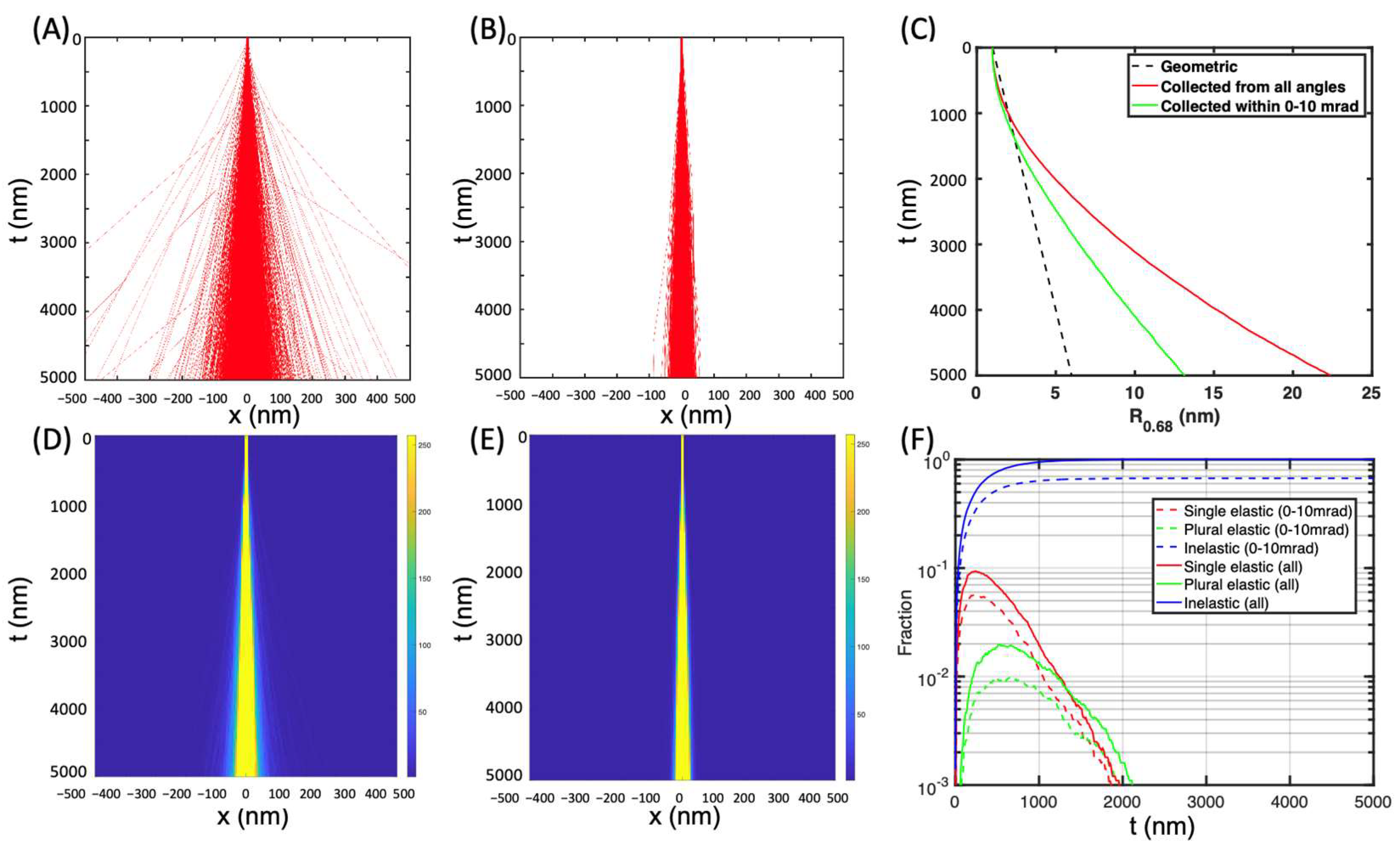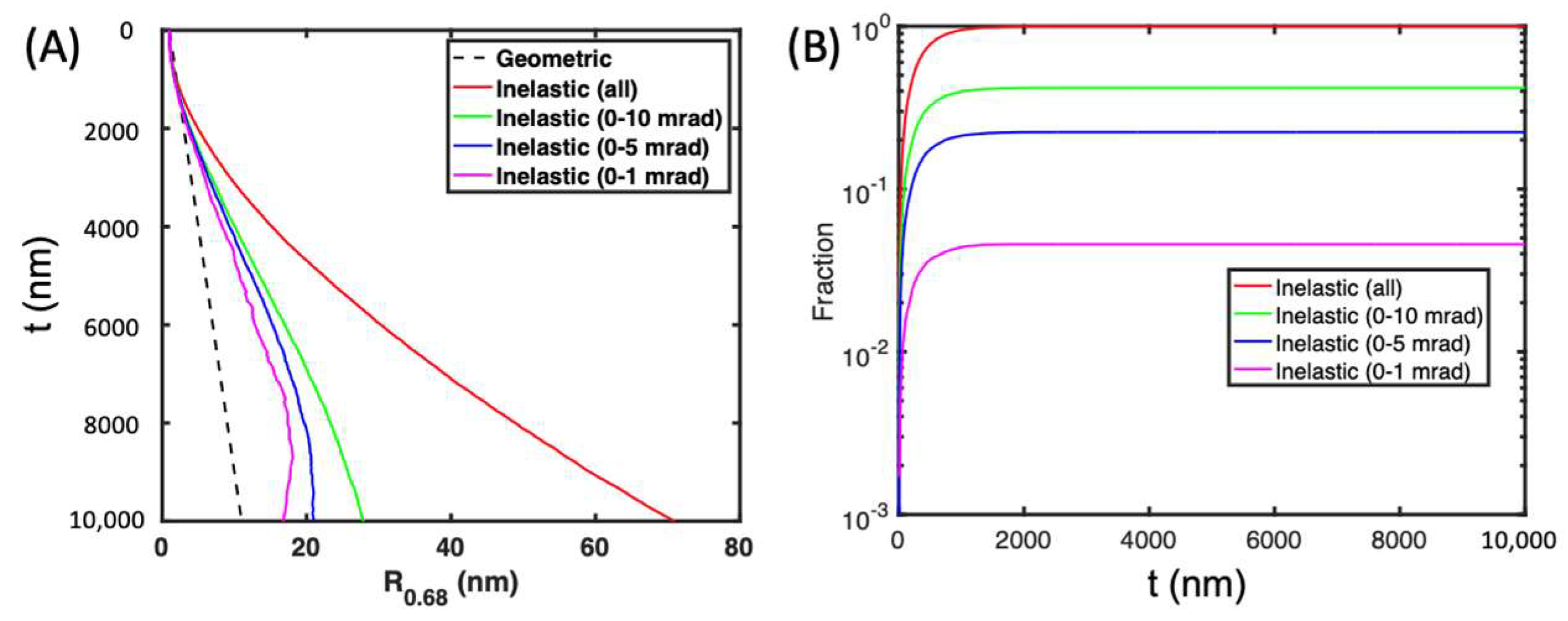Monte Carlo Simulation of Electron Interactions in an MeV-STEM for Thick Frozen Biological Sample Imaging
Abstract
1. Introduction
2. Methods
2.1. Model Electron Cross-Section Formulae
- Inoscat designates electrons undergoing no scattering;
- I1el designates electrons being elastically scattered once, remaining within the detector collection angles;
- Iel,plural designates electrons undergoing multiple elastic scatterings without any inelastic scatterings and remaining within the detector collection angles;
- Iinel designates electrons undergoing at least one inelastic scattering and remaining within the detector collection angles;
- Iout designates electrons being scattered outside the detector collection angles.
2.2. MC Simulation
3. Results
3.1. Electron Beam Propagation in Vacuum
3.2. Electron Intensity in Amorphous Ice at 300 keV
3.3. Electron Intensity in Amorphous Ice at 3 MeV
3.4. Effect of Collection Angle on Electron Intensity in Amorphous Ice at 3 MeV
3.5. Effect of Imaging Modes on Electron Intensity in Amorphous Ice at 3 MeV
4. Discussion
Author Contributions
Funding
Data Availability Statement
Acknowledgments
Conflicts of Interest
References
- Cooper, C.; Thompson, R.C.A.; Clode, P.L. Investigating parasites in three dimensions: Trends in volume microscopy. Trends Parasitol. 2023, 39, 668–681. [Google Scholar] [CrossRef]
- Collinson, L.M.; Bosch, C.; Bullen, A.; Burden, J.J.; Carzaniga, R.; Cheng, C.; Darrow, M.C.; Fletcher, G.; Johnson, E.; Narayan, K.; et al. Volume EM: A quiet revolution takes shape. Nat. Methods 2023, 20, 777–782. [Google Scholar] [CrossRef]
- Capua-Shenkar, J.; Varsano, N.; Itzhak, N.R.; Kaplan-Ashiri, I.; Rechav, K.; Jin, X.; Niimi, M.; Fan, J.; Kruth, H.S.; Addadi, L. Examining atherosclerotic lesions in three dimensions at the nanometer scale with cryo-FIB-SEM. Proc. Natl. Acad. Sci. USA 2022, 119, e2205475119. [Google Scholar] [CrossRef]
- Schertel, A.; Snaidero, N.; Han, H.M.; Ruhwedel, T.; Laue, M.; Grabenbauer, M.; Möbius, W. Cryo FIB-SEM: Volume imaging of cellular ultrastructure in native frozen specimens. J. Struct. Biol. 2013, 184, 355–360. [Google Scholar] [CrossRef]
- Spehner, D.; Steyer, A.M.; Bertinetti, L.; Orlov, I.; Benoit, L.; Pernet-Gallay, K.; Schertel, A.; Schultz, P. Cryo-FIB-SEM as a promising tool for localizing proteins in 3D. J. Struct. Biol. 2020, 211, 107528. [Google Scholar] [CrossRef]
- Vidavsky, N.; Akiva, A.; Kaplan-Ashiri, I.; Rechav, K.; Addadi, L.; Weiner, S.; Schertel, A. Cryo-FIB-SEM serial milling and block face imaging: Large volume structural analysis of biological tissues preserved close to their native state. J. Struct. Biol. 2016, 196, 487–495. [Google Scholar] [CrossRef]
- Raguin, E.; Weinkamer, R.; Schmitt, C.; Curcuraci, L.; Fratzl, P. Logistics of Bone Mineralization in the Chick Embryo Studied by 3D Cryo FIB-SEM Imaging. Adv. Sci. 2023, 10, e2301231. [Google Scholar] [CrossRef] [PubMed]
- Wolf, S.G.; Elbaum, M. CryoSTEM tomography in biology. Methods Cell Biol. 2019, 152, 197–215. [Google Scholar] [CrossRef] [PubMed]
- Hohmann-Marriott, M.F.; Sousa, A.A.; Azari, A.A.; Glushakova, S.; Zhang, G.; Zimmerberg, J.; Leapman, R.D. Nanoscale 3D cellular imaging by axial scanning transmission electron tomography. Nat. Methods 2009, 6, 729–731. [Google Scholar] [CrossRef] [PubMed]
- Wolf, S.G.; Shimoni, E.; Elbaum, M.; Houben, L. Cellular Imaging: Electron Tomography and Related Techniques; Hanssen, E., Ed.; Springer International Publishing: Cham, Switzerland, 2018; pp. 33–60. [Google Scholar]
- Wolf, S.G.; Houben, L.; Elbaum, M. Cryo-scanning transmission electron tomography of vitrified cells. Nat. Methods 2014, 11, 423–428. [Google Scholar] [CrossRef] [PubMed]
- Weiner, E.; Pinskey, J.M.; Nicastro, D.; Otegui, M.S. Electron microscopy for imaging organelles in plants and algae. Plant Physiol. 2022, 188, 713–725. [Google Scholar] [CrossRef]
- Böhning, J.; Bharat, T.A.M. Towards high-throughput in situ structural biology using electron cryotomography. Prog. Biophys. Mol. Biol. 2021, 160, 97–103. [Google Scholar] [CrossRef] [PubMed]
- Oikonomou, C.M.; Jensen, G.J. Cellular Electron Cryotomography: Toward Structural Biology In Situ. Annu. Rev. Biochem. 2017, 86, 873–896. [Google Scholar] [CrossRef] [PubMed]
- Otegui, M.S.; Pennington, J.G. Electron tomography in plant cell biology. Microscopy 2019, 68, 69–79. [Google Scholar] [CrossRef] [PubMed]
- Hawkes, P.W. Advances in Imaging and Electron Physics; Elsevier: Pheladelphia, PA, USA, 2009; Volume 159. [Google Scholar]
- Reimer, L.; Kohl, H. Transmission Electron Microscopy: Physics of Image Formation, 5th ed.; Springer: New York, NY, USA, 2008. [Google Scholar]
- Tanaka, N. Electron Nano-Imaging Basics of Imaging and Diffraction for TEM and STEM, 1st ed.; Springer: Tokyo, Japan, 2017. [Google Scholar]
- Yang, X.; Wang, L.; Maxson, J.; Bartnik, A.; Kaemingk, M.; Wan, W.; Cultrera, L.; Wu, L.; Smaluk, V.; Shaftan, T.; et al. Towards construction of a novel nm resolution MeV-STEM for imaging of thick biological samples. arXiv 2023. [Google Scholar] [CrossRef]
- Wu, L.; Zhu, Y.; Vogt, T.; Su, H.; Davenport, J.W.; Tafto, J. Valence-electron distribution inMgB2by accurate diffraction measurements and first-principles calculations. Phys. Rev. B Condens. Matter Mater. Phys. 2004, 69, 064501. [Google Scholar] [CrossRef]
- Li, J.; Yin, W.G.; Wu, L.; Zhu, P.; Konstantinova, T.; Tao, J.; Yang, J.; Cheong, S.W.; Carbone, F.; Misewich, J.A.; et al. Dichotomy in ultrafast atomic dynamics as direct evidence of polaron formation in manganites. npj Quantum Mater. 2016, 1, 16026. [Google Scholar] [CrossRef]
- Metropolis, N.; Ulam, S. The Monte Carlo method. J. Am. Stat. Assoc. 1949, 44, 335–341. [Google Scholar] [CrossRef]
- Newman, M.E.J.; Barkema, G.T. Monte Carlo Methods in Statistical Physic; Clarendon Press: Oxford, UK, 1999. [Google Scholar]
- Rubinstein, R.Y. Simulation and the Monte Carlo Method; Wiley: Hoboken, NJ, USA, 1981. [Google Scholar]
- Fielding, A.L. Monte-Carlo techniques for radiotherapy applications I: Introduction and overview of the different Monte-Carlo codes. J. Radiother. Pract. 2023, 22, e80. [Google Scholar] [CrossRef]
- Hahn, M.B. Accessing radiation damage to biomolecules on the nanoscale by particle-scattering simulations. J. Phys. Commun. 2023, 7, 042001. [Google Scholar] [CrossRef]
- Emfietzoglou, D.; Karava, K.; Papamichael, G.; Moscovitch, M. Monte Carlo simulation of the energy loss of low-energy electrons in liquid water. Phys. Med. Biol. 2003, 48, 2355. [Google Scholar] [CrossRef]
- Langmore, J.P.; Smith, M.F. Quantitative energy-filtered electron-microscopy of biological molecules in ice. Ultramicroscopy 1992, 46, 349–373. [Google Scholar] [CrossRef] [PubMed][Green Version]
- Jacobsen, C.; Medenwaldt, R.; Williams, S. X-ray Microscopy and Spectromicroscopy: Status Report from the Fifth International Conference, Würzburg, August 19–23, 1996; Thieme, J., Schmahl, G., Rudolph, D., Umbach, E., Eds.; Springer: Berlin/Heidelberg, Germany, 1998; pp. 197–206. [Google Scholar]
- Du, M.; Jacobsen, C. Relative merits and limiting factors for x-ray and electron microscopy of thick, hydrated organic materials. Ultramicroscopy 2018, 184, 293–309. [Google Scholar] [CrossRef] [PubMed]
- Williams, D.B.; Carter, C.B. Transmission Electron Microscopy; Springer: New York, NY, USA, 2009. [Google Scholar]
- Henderson, R. The potential and limitations of neutrons, electrons and X-rays for atomic resolution microscopy of unstained biological molecules. Q. Rev. Biophys. 1995, 28, 171–193. [Google Scholar] [CrossRef] [PubMed]
- Peet, M.J.; Henderson, R.; Russo, C.J. The energy dependence of contrast and damage in electron cryomicroscopy of biological molecules. Ultramicroscopy 2019, 203, 125–131. [Google Scholar] [CrossRef]







| Elastic Cross-Section (nm2) | Inelastic Cross-Section (nm2) | |||||||||
|---|---|---|---|---|---|---|---|---|---|---|
| Detector Collection Angle | Detector Collection Angle | |||||||||
| Electron Energy (eV) | θ0 (mrad) | 0–10 mrad | 10–50 mrad | 50–100 mrad | Total | θE (mrad) | 0–10 mrad | 10–50 mrad | 50–100 mrad | Total |
| 100,000 | 22.3 | 1.7 × 10−5 | 6.7 × 10−5 | 1.6 × 10−5 | 1.0 × 10−4 | 0.214 | 1.6 × 10−4 | 3.1 × 10−5 | 2.4 × 10−6 | 1.9 × 10−4 |
| 200,000 | 15.1 | 1.9 × 10−5 | 3.8 × 10−5 | 5.1 × 10−6 | 6.2 × 10−5 | 0.114 | 1.1 × 10−4 | 1.2 × 10−5 | 6.9 × 10−7 | 1.3 × 10−4 |
| 300,000 | 11.8 | 2.1 × 10−5 | 2.6 × 10−5 | 2.6 × 10−6 | 5.0 × 10−5 | 0.080 | 9.4 × 10−5 | 6.8 × 10−6 | 3.4 × 10−7 | 1.0 × 10−4 |
| 1,000,000 | 5.2 | 2.7 × 10−5 | 6.8 × 10−6 | 3.6 × 10−7 | 3.4 × 10−5 | 0.029 | 5.9 × 10−5 | 1.1 × 10−6 | 4.6 × 10−8 | 6.0 × 10−5 |
| 3,000,000 | 2.1 | 2.9 × 10−5 | 1.3 × 10−6 | 5.5 × 10−8 | 3.1 × 10−5 | 0.011 | 4.1 × 10−5 | 1.7 × 10−7 | 6.9 × 10−9 | 4.1 × 10−5 |
Disclaimer/Publisher’s Note: The statements, opinions and data contained in all publications are solely those of the individual author(s) and contributor(s) and not of MDPI and/or the editor(s). MDPI and/or the editor(s) disclaim responsibility for any injury to people or property resulting from any ideas, methods, instructions or products referred to in the content. |
© 2024 by the authors. Licensee MDPI, Basel, Switzerland. This article is an open access article distributed under the terms and conditions of the Creative Commons Attribution (CC BY) license (https://creativecommons.org/licenses/by/4.0/).
Share and Cite
Wang, L.; Yang, X. Monte Carlo Simulation of Electron Interactions in an MeV-STEM for Thick Frozen Biological Sample Imaging. Appl. Sci. 2024, 14, 1888. https://doi.org/10.3390/app14051888
Wang L, Yang X. Monte Carlo Simulation of Electron Interactions in an MeV-STEM for Thick Frozen Biological Sample Imaging. Applied Sciences. 2024; 14(5):1888. https://doi.org/10.3390/app14051888
Chicago/Turabian StyleWang, Liguo, and Xi Yang. 2024. "Monte Carlo Simulation of Electron Interactions in an MeV-STEM for Thick Frozen Biological Sample Imaging" Applied Sciences 14, no. 5: 1888. https://doi.org/10.3390/app14051888
APA StyleWang, L., & Yang, X. (2024). Monte Carlo Simulation of Electron Interactions in an MeV-STEM for Thick Frozen Biological Sample Imaging. Applied Sciences, 14(5), 1888. https://doi.org/10.3390/app14051888






